Talent Management: Importance, Implications, and Strategies
VerifiedAdded on 2023/06/17
|13
|3226
|264
Report
AI Summary
This report delves into the critical aspects of talent management within a business context, focusing on its importance, effective strategies, and implementation challenges, particularly within the case study of Digitavia. It begins with a literature review highlighting the significance of talent management in retaining and attracting high-quality employees, fostering motivation, and enhancing overall performance, while also acknowledging the potential drawbacks such as high costs and conflicts between management and HR. The report analyzes various talent management strategies, including hiring top talent, promising specialists, or a combination of both, weighing their respective advantages and disadvantages. Furthermore, it addresses the challenges in implementing talent management, such as employee retention, conflicting views among leaders, and the substantial investment required for training and development. The research methodology employed involves both primary and secondary data collection, utilizing questionnaires and existing research articles. The questionnaire results reveal a strong consensus on the importance of talent management in Digitavia and its positive impact on organizational growth. The report concludes by emphasizing the need for Digitavia to focus on employee motivation, feedback, career development, and standardized onboarding processes to overcome talent management challenges and achieve sustainable growth. Desklib provides access to this and other solved assignments to aid students in their studies.

UNIT 11
Paraphrase This Document
Need a fresh take? Get an instant paraphrase of this document with our AI Paraphraser
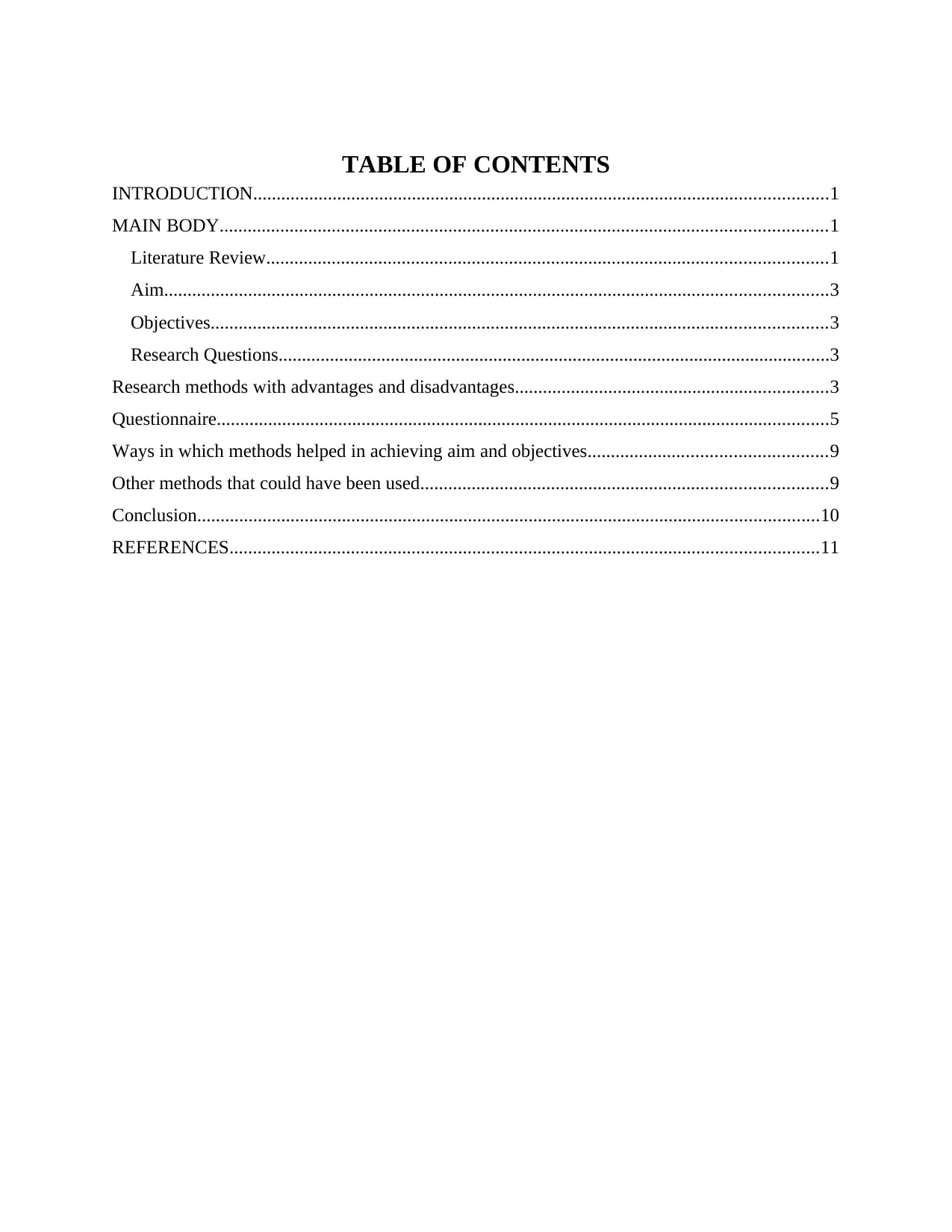
TABLE OF CONTENTS
INTRODUCTION...........................................................................................................................1
MAIN BODY..................................................................................................................................1
Literature Review........................................................................................................................1
Aim..............................................................................................................................................3
Objectives....................................................................................................................................3
Research Questions......................................................................................................................3
Research methods with advantages and disadvantages...................................................................3
Questionnaire...................................................................................................................................5
Ways in which methods helped in achieving aim and objectives...................................................9
Other methods that could have been used.......................................................................................9
Conclusion.....................................................................................................................................10
REFERENCES..............................................................................................................................11
INTRODUCTION...........................................................................................................................1
MAIN BODY..................................................................................................................................1
Literature Review........................................................................................................................1
Aim..............................................................................................................................................3
Objectives....................................................................................................................................3
Research Questions......................................................................................................................3
Research methods with advantages and disadvantages...................................................................3
Questionnaire...................................................................................................................................5
Ways in which methods helped in achieving aim and objectives...................................................9
Other methods that could have been used.......................................................................................9
Conclusion.....................................................................................................................................10
REFERENCES..............................................................................................................................11
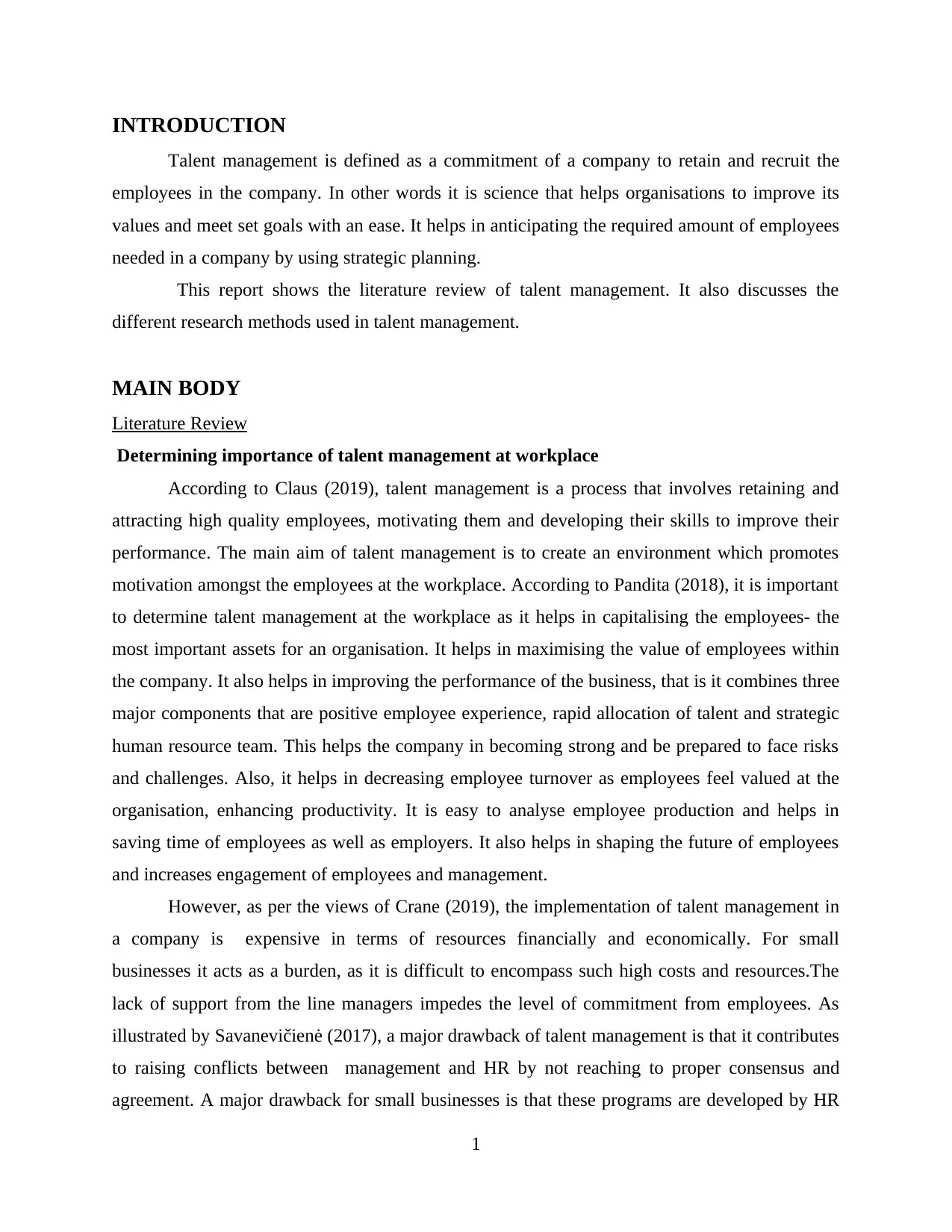
INTRODUCTION
Talent management is defined as a commitment of a company to retain and recruit the
employees in the company. In other words it is science that helps organisations to improve its
values and meet set goals with an ease. It helps in anticipating the required amount of employees
needed in a company by using strategic planning.
This report shows the literature review of talent management. It also discusses the
different research methods used in talent management.
MAIN BODY
Literature Review
Determining importance of talent management at workplace
According to Claus (2019), talent management is a process that involves retaining and
attracting high quality employees, motivating them and developing their skills to improve their
performance. The main aim of talent management is to create an environment which promotes
motivation amongst the employees at the workplace. According to Pandita (2018), it is important
to determine talent management at the workplace as it helps in capitalising the employees- the
most important assets for an organisation. It helps in maximising the value of employees within
the company. It also helps in improving the performance of the business, that is it combines three
major components that are positive employee experience, rapid allocation of talent and strategic
human resource team. This helps the company in becoming strong and be prepared to face risks
and challenges. Also, it helps in decreasing employee turnover as employees feel valued at the
organisation, enhancing productivity. It is easy to analyse employee production and helps in
saving time of employees as well as employers. It also helps in shaping the future of employees
and increases engagement of employees and management.
However, as per the views of Crane (2019), the implementation of talent management in
a company is expensive in terms of resources financially and economically. For small
businesses it acts as a burden, as it is difficult to encompass such high costs and resources.The
lack of support from the line managers impedes the level of commitment from employees. As
illustrated by Savanevičienė (2017), a major drawback of talent management is that it contributes
to raising conflicts between management and HR by not reaching to proper consensus and
agreement. A major drawback for small businesses is that these programs are developed by HR
1
Talent management is defined as a commitment of a company to retain and recruit the
employees in the company. In other words it is science that helps organisations to improve its
values and meet set goals with an ease. It helps in anticipating the required amount of employees
needed in a company by using strategic planning.
This report shows the literature review of talent management. It also discusses the
different research methods used in talent management.
MAIN BODY
Literature Review
Determining importance of talent management at workplace
According to Claus (2019), talent management is a process that involves retaining and
attracting high quality employees, motivating them and developing their skills to improve their
performance. The main aim of talent management is to create an environment which promotes
motivation amongst the employees at the workplace. According to Pandita (2018), it is important
to determine talent management at the workplace as it helps in capitalising the employees- the
most important assets for an organisation. It helps in maximising the value of employees within
the company. It also helps in improving the performance of the business, that is it combines three
major components that are positive employee experience, rapid allocation of talent and strategic
human resource team. This helps the company in becoming strong and be prepared to face risks
and challenges. Also, it helps in decreasing employee turnover as employees feel valued at the
organisation, enhancing productivity. It is easy to analyse employee production and helps in
saving time of employees as well as employers. It also helps in shaping the future of employees
and increases engagement of employees and management.
However, as per the views of Crane (2019), the implementation of talent management in
a company is expensive in terms of resources financially and economically. For small
businesses it acts as a burden, as it is difficult to encompass such high costs and resources.The
lack of support from the line managers impedes the level of commitment from employees. As
illustrated by Savanevičienė (2017), a major drawback of talent management is that it contributes
to raising conflicts between management and HR by not reaching to proper consensus and
agreement. A major drawback for small businesses is that these programs are developed by HR
1
⊘ This is a preview!⊘
Do you want full access?
Subscribe today to unlock all pages.

Trusted by 1+ million students worldwide
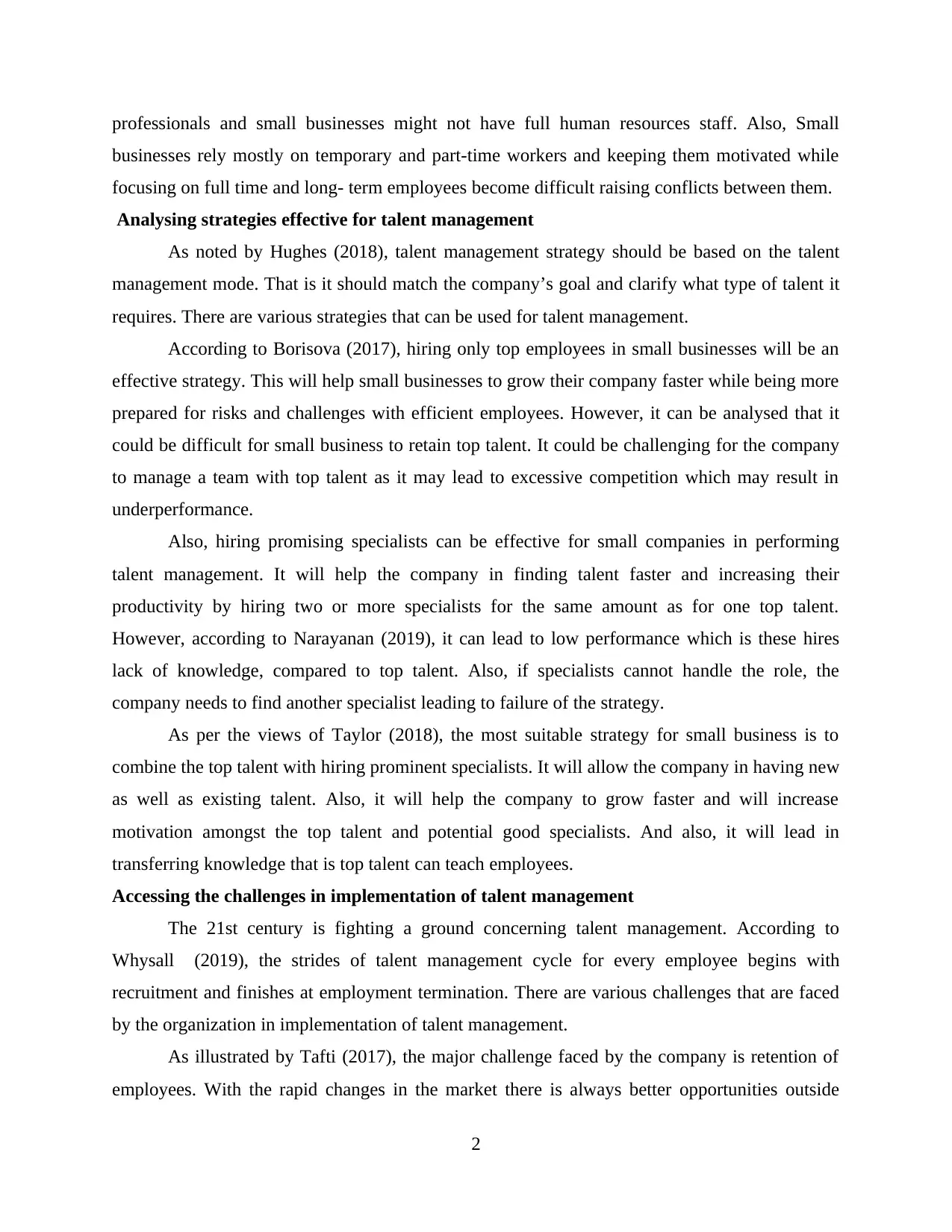
professionals and small businesses might not have full human resources staff. Also, Small
businesses rely mostly on temporary and part-time workers and keeping them motivated while
focusing on full time and long- term employees become difficult raising conflicts between them.
Analysing strategies effective for talent management
As noted by Hughes (2018), talent management strategy should be based on the talent
management mode. That is it should match the company’s goal and clarify what type of talent it
requires. There are various strategies that can be used for talent management.
According to Borisova (2017), hiring only top employees in small businesses will be an
effective strategy. This will help small businesses to grow their company faster while being more
prepared for risks and challenges with efficient employees. However, it can be analysed that it
could be difficult for small business to retain top talent. It could be challenging for the company
to manage a team with top talent as it may lead to excessive competition which may result in
underperformance.
Also, hiring promising specialists can be effective for small companies in performing
talent management. It will help the company in finding talent faster and increasing their
productivity by hiring two or more specialists for the same amount as for one top talent.
However, according to Narayanan (2019), it can lead to low performance which is these hires
lack of knowledge, compared to top talent. Also, if specialists cannot handle the role, the
company needs to find another specialist leading to failure of the strategy.
As per the views of Taylor (2018), the most suitable strategy for small business is to
combine the top talent with hiring prominent specialists. It will allow the company in having new
as well as existing talent. Also, it will help the company to grow faster and will increase
motivation amongst the top talent and potential good specialists. And also, it will lead in
transferring knowledge that is top talent can teach employees.
Accessing the challenges in implementation of talent management
The 21st century is fighting a ground concerning talent management. According to
Whysall (2019), the strides of talent management cycle for every employee begins with
recruitment and finishes at employment termination. There are various challenges that are faced
by the organization in implementation of talent management.
As illustrated by Tafti (2017), the major challenge faced by the company is retention of
employees. With the rapid changes in the market there is always better opportunities outside
2
businesses rely mostly on temporary and part-time workers and keeping them motivated while
focusing on full time and long- term employees become difficult raising conflicts between them.
Analysing strategies effective for talent management
As noted by Hughes (2018), talent management strategy should be based on the talent
management mode. That is it should match the company’s goal and clarify what type of talent it
requires. There are various strategies that can be used for talent management.
According to Borisova (2017), hiring only top employees in small businesses will be an
effective strategy. This will help small businesses to grow their company faster while being more
prepared for risks and challenges with efficient employees. However, it can be analysed that it
could be difficult for small business to retain top talent. It could be challenging for the company
to manage a team with top talent as it may lead to excessive competition which may result in
underperformance.
Also, hiring promising specialists can be effective for small companies in performing
talent management. It will help the company in finding talent faster and increasing their
productivity by hiring two or more specialists for the same amount as for one top talent.
However, according to Narayanan (2019), it can lead to low performance which is these hires
lack of knowledge, compared to top talent. Also, if specialists cannot handle the role, the
company needs to find another specialist leading to failure of the strategy.
As per the views of Taylor (2018), the most suitable strategy for small business is to
combine the top talent with hiring prominent specialists. It will allow the company in having new
as well as existing talent. Also, it will help the company to grow faster and will increase
motivation amongst the top talent and potential good specialists. And also, it will lead in
transferring knowledge that is top talent can teach employees.
Accessing the challenges in implementation of talent management
The 21st century is fighting a ground concerning talent management. According to
Whysall (2019), the strides of talent management cycle for every employee begins with
recruitment and finishes at employment termination. There are various challenges that are faced
by the organization in implementation of talent management.
As illustrated by Tafti (2017), the major challenge faced by the company is retention of
employees. With the rapid changes in the market there is always better opportunities outside
2
Paraphrase This Document
Need a fresh take? Get an instant paraphrase of this document with our AI Paraphraser
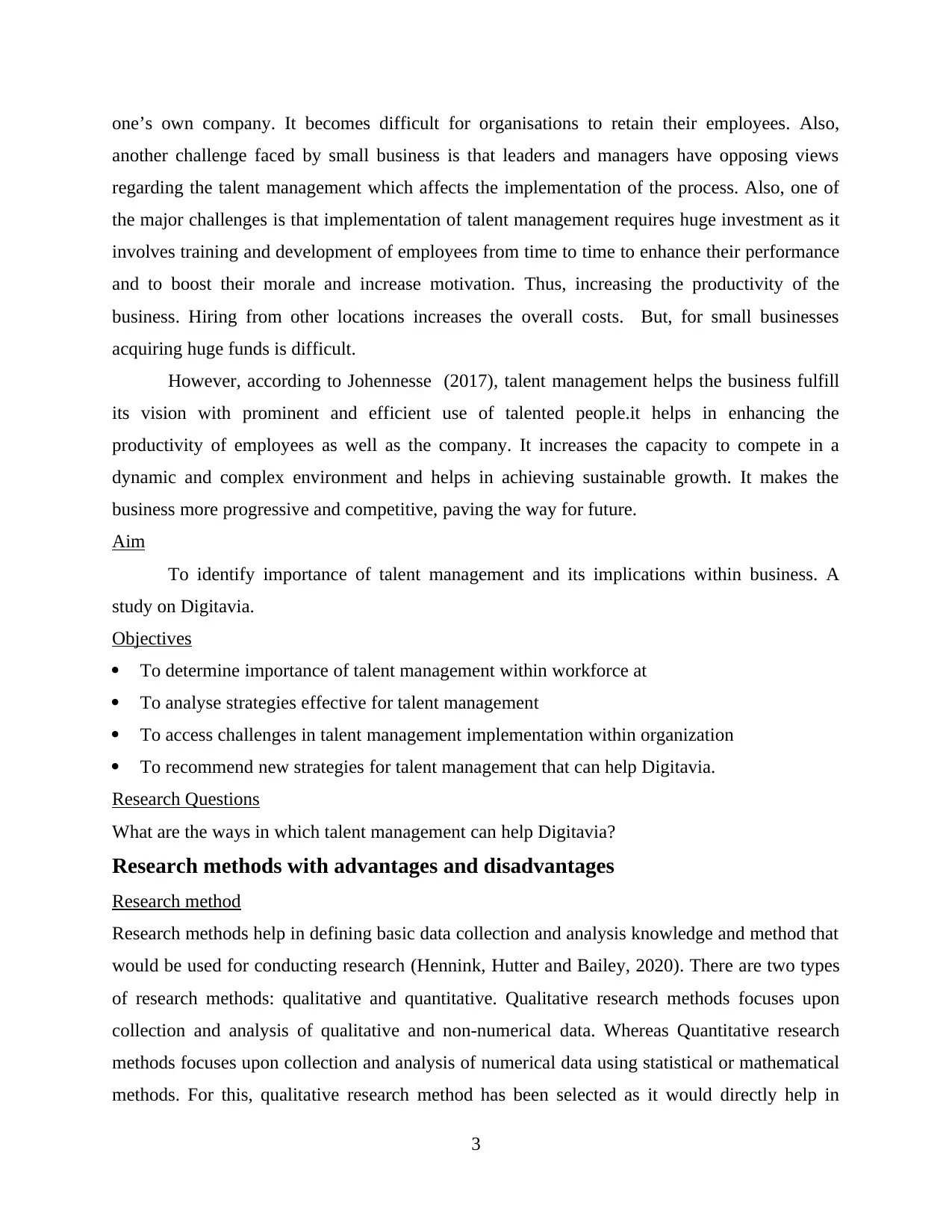
one’s own company. It becomes difficult for organisations to retain their employees. Also,
another challenge faced by small business is that leaders and managers have opposing views
regarding the talent management which affects the implementation of the process. Also, one of
the major challenges is that implementation of talent management requires huge investment as it
involves training and development of employees from time to time to enhance their performance
and to boost their morale and increase motivation. Thus, increasing the productivity of the
business. Hiring from other locations increases the overall costs. But, for small businesses
acquiring huge funds is difficult.
However, according to Johennesse (2017), talent management helps the business fulfill
its vision with prominent and efficient use of talented people.it helps in enhancing the
productivity of employees as well as the company. It increases the capacity to compete in a
dynamic and complex environment and helps in achieving sustainable growth. It makes the
business more progressive and competitive, paving the way for future.
Aim
To identify importance of talent management and its implications within business. A
study on Digitavia.
Objectives
To determine importance of talent management within workforce at
To analyse strategies effective for talent management
To access challenges in talent management implementation within organization
To recommend new strategies for talent management that can help Digitavia.
Research Questions
What are the ways in which talent management can help Digitavia?
Research methods with advantages and disadvantages
Research method
Research methods help in defining basic data collection and analysis knowledge and method that
would be used for conducting research (Hennink, Hutter and Bailey, 2020). There are two types
of research methods: qualitative and quantitative. Qualitative research methods focuses upon
collection and analysis of qualitative and non-numerical data. Whereas Quantitative research
methods focuses upon collection and analysis of numerical data using statistical or mathematical
methods. For this, qualitative research method has been selected as it would directly help in
3
another challenge faced by small business is that leaders and managers have opposing views
regarding the talent management which affects the implementation of the process. Also, one of
the major challenges is that implementation of talent management requires huge investment as it
involves training and development of employees from time to time to enhance their performance
and to boost their morale and increase motivation. Thus, increasing the productivity of the
business. Hiring from other locations increases the overall costs. But, for small businesses
acquiring huge funds is difficult.
However, according to Johennesse (2017), talent management helps the business fulfill
its vision with prominent and efficient use of talented people.it helps in enhancing the
productivity of employees as well as the company. It increases the capacity to compete in a
dynamic and complex environment and helps in achieving sustainable growth. It makes the
business more progressive and competitive, paving the way for future.
Aim
To identify importance of talent management and its implications within business. A
study on Digitavia.
Objectives
To determine importance of talent management within workforce at
To analyse strategies effective for talent management
To access challenges in talent management implementation within organization
To recommend new strategies for talent management that can help Digitavia.
Research Questions
What are the ways in which talent management can help Digitavia?
Research methods with advantages and disadvantages
Research method
Research methods help in defining basic data collection and analysis knowledge and method that
would be used for conducting research (Hennink, Hutter and Bailey, 2020). There are two types
of research methods: qualitative and quantitative. Qualitative research methods focuses upon
collection and analysis of qualitative and non-numerical data. Whereas Quantitative research
methods focuses upon collection and analysis of numerical data using statistical or mathematical
methods. For this, qualitative research method has been selected as it would directly help in
3
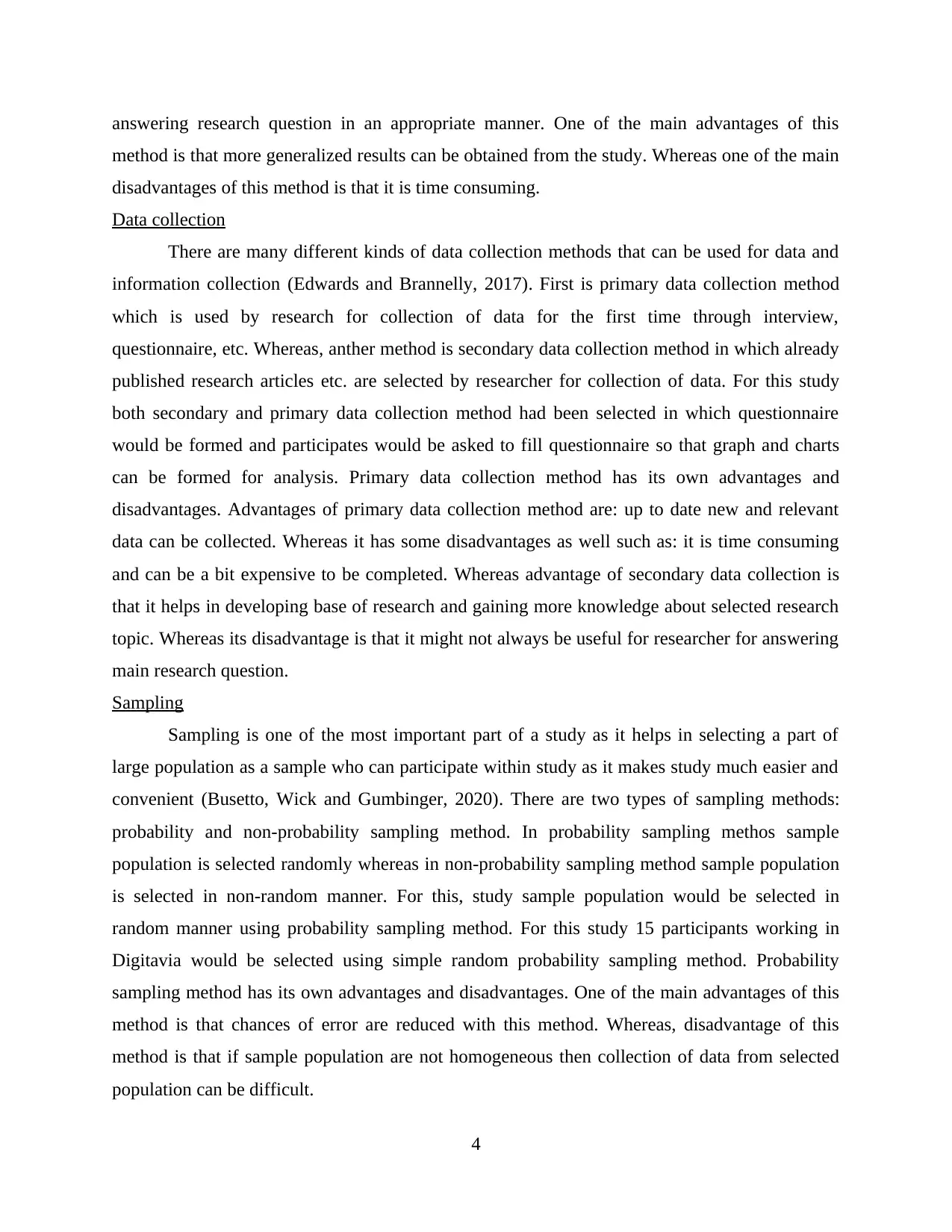
answering research question in an appropriate manner. One of the main advantages of this
method is that more generalized results can be obtained from the study. Whereas one of the main
disadvantages of this method is that it is time consuming.
Data collection
There are many different kinds of data collection methods that can be used for data and
information collection (Edwards and Brannelly, 2017). First is primary data collection method
which is used by research for collection of data for the first time through interview,
questionnaire, etc. Whereas, anther method is secondary data collection method in which already
published research articles etc. are selected by researcher for collection of data. For this study
both secondary and primary data collection method had been selected in which questionnaire
would be formed and participates would be asked to fill questionnaire so that graph and charts
can be formed for analysis. Primary data collection method has its own advantages and
disadvantages. Advantages of primary data collection method are: up to date new and relevant
data can be collected. Whereas it has some disadvantages as well such as: it is time consuming
and can be a bit expensive to be completed. Whereas advantage of secondary data collection is
that it helps in developing base of research and gaining more knowledge about selected research
topic. Whereas its disadvantage is that it might not always be useful for researcher for answering
main research question.
Sampling
Sampling is one of the most important part of a study as it helps in selecting a part of
large population as a sample who can participate within study as it makes study much easier and
convenient (Busetto, Wick and Gumbinger, 2020). There are two types of sampling methods:
probability and non-probability sampling method. In probability sampling methos sample
population is selected randomly whereas in non-probability sampling method sample population
is selected in non-random manner. For this, study sample population would be selected in
random manner using probability sampling method. For this study 15 participants working in
Digitavia would be selected using simple random probability sampling method. Probability
sampling method has its own advantages and disadvantages. One of the main advantages of this
method is that chances of error are reduced with this method. Whereas, disadvantage of this
method is that if sample population are not homogeneous then collection of data from selected
population can be difficult.
4
method is that more generalized results can be obtained from the study. Whereas one of the main
disadvantages of this method is that it is time consuming.
Data collection
There are many different kinds of data collection methods that can be used for data and
information collection (Edwards and Brannelly, 2017). First is primary data collection method
which is used by research for collection of data for the first time through interview,
questionnaire, etc. Whereas, anther method is secondary data collection method in which already
published research articles etc. are selected by researcher for collection of data. For this study
both secondary and primary data collection method had been selected in which questionnaire
would be formed and participates would be asked to fill questionnaire so that graph and charts
can be formed for analysis. Primary data collection method has its own advantages and
disadvantages. Advantages of primary data collection method are: up to date new and relevant
data can be collected. Whereas it has some disadvantages as well such as: it is time consuming
and can be a bit expensive to be completed. Whereas advantage of secondary data collection is
that it helps in developing base of research and gaining more knowledge about selected research
topic. Whereas its disadvantage is that it might not always be useful for researcher for answering
main research question.
Sampling
Sampling is one of the most important part of a study as it helps in selecting a part of
large population as a sample who can participate within study as it makes study much easier and
convenient (Busetto, Wick and Gumbinger, 2020). There are two types of sampling methods:
probability and non-probability sampling method. In probability sampling methos sample
population is selected randomly whereas in non-probability sampling method sample population
is selected in non-random manner. For this, study sample population would be selected in
random manner using probability sampling method. For this study 15 participants working in
Digitavia would be selected using simple random probability sampling method. Probability
sampling method has its own advantages and disadvantages. One of the main advantages of this
method is that chances of error are reduced with this method. Whereas, disadvantage of this
method is that if sample population are not homogeneous then collection of data from selected
population can be difficult.
4
⊘ This is a preview!⊘
Do you want full access?
Subscribe today to unlock all pages.

Trusted by 1+ million students worldwide
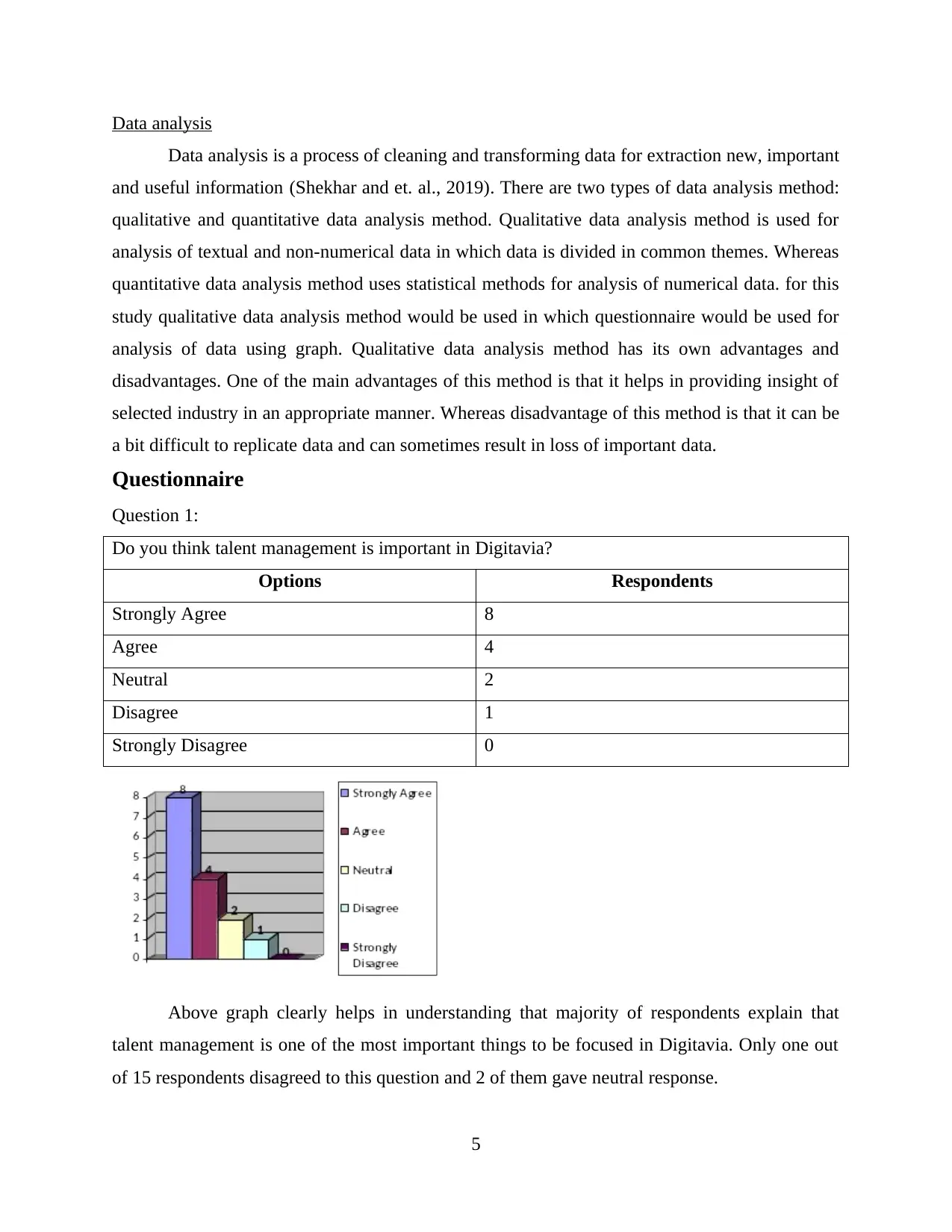
Data analysis
Data analysis is a process of cleaning and transforming data for extraction new, important
and useful information (Shekhar and et. al., 2019). There are two types of data analysis method:
qualitative and quantitative data analysis method. Qualitative data analysis method is used for
analysis of textual and non-numerical data in which data is divided in common themes. Whereas
quantitative data analysis method uses statistical methods for analysis of numerical data. for this
study qualitative data analysis method would be used in which questionnaire would be used for
analysis of data using graph. Qualitative data analysis method has its own advantages and
disadvantages. One of the main advantages of this method is that it helps in providing insight of
selected industry in an appropriate manner. Whereas disadvantage of this method is that it can be
a bit difficult to replicate data and can sometimes result in loss of important data.
Questionnaire
Question 1:
Do you think talent management is important in Digitavia?
Options Respondents
Strongly Agree 8
Agree 4
Neutral 2
Disagree 1
Strongly Disagree 0
Above graph clearly helps in understanding that majority of respondents explain that
talent management is one of the most important things to be focused in Digitavia. Only one out
of 15 respondents disagreed to this question and 2 of them gave neutral response.
5
Data analysis is a process of cleaning and transforming data for extraction new, important
and useful information (Shekhar and et. al., 2019). There are two types of data analysis method:
qualitative and quantitative data analysis method. Qualitative data analysis method is used for
analysis of textual and non-numerical data in which data is divided in common themes. Whereas
quantitative data analysis method uses statistical methods for analysis of numerical data. for this
study qualitative data analysis method would be used in which questionnaire would be used for
analysis of data using graph. Qualitative data analysis method has its own advantages and
disadvantages. One of the main advantages of this method is that it helps in providing insight of
selected industry in an appropriate manner. Whereas disadvantage of this method is that it can be
a bit difficult to replicate data and can sometimes result in loss of important data.
Questionnaire
Question 1:
Do you think talent management is important in Digitavia?
Options Respondents
Strongly Agree 8
Agree 4
Neutral 2
Disagree 1
Strongly Disagree 0
Above graph clearly helps in understanding that majority of respondents explain that
talent management is one of the most important things to be focused in Digitavia. Only one out
of 15 respondents disagreed to this question and 2 of them gave neutral response.
5
Paraphrase This Document
Need a fresh take? Get an instant paraphrase of this document with our AI Paraphraser
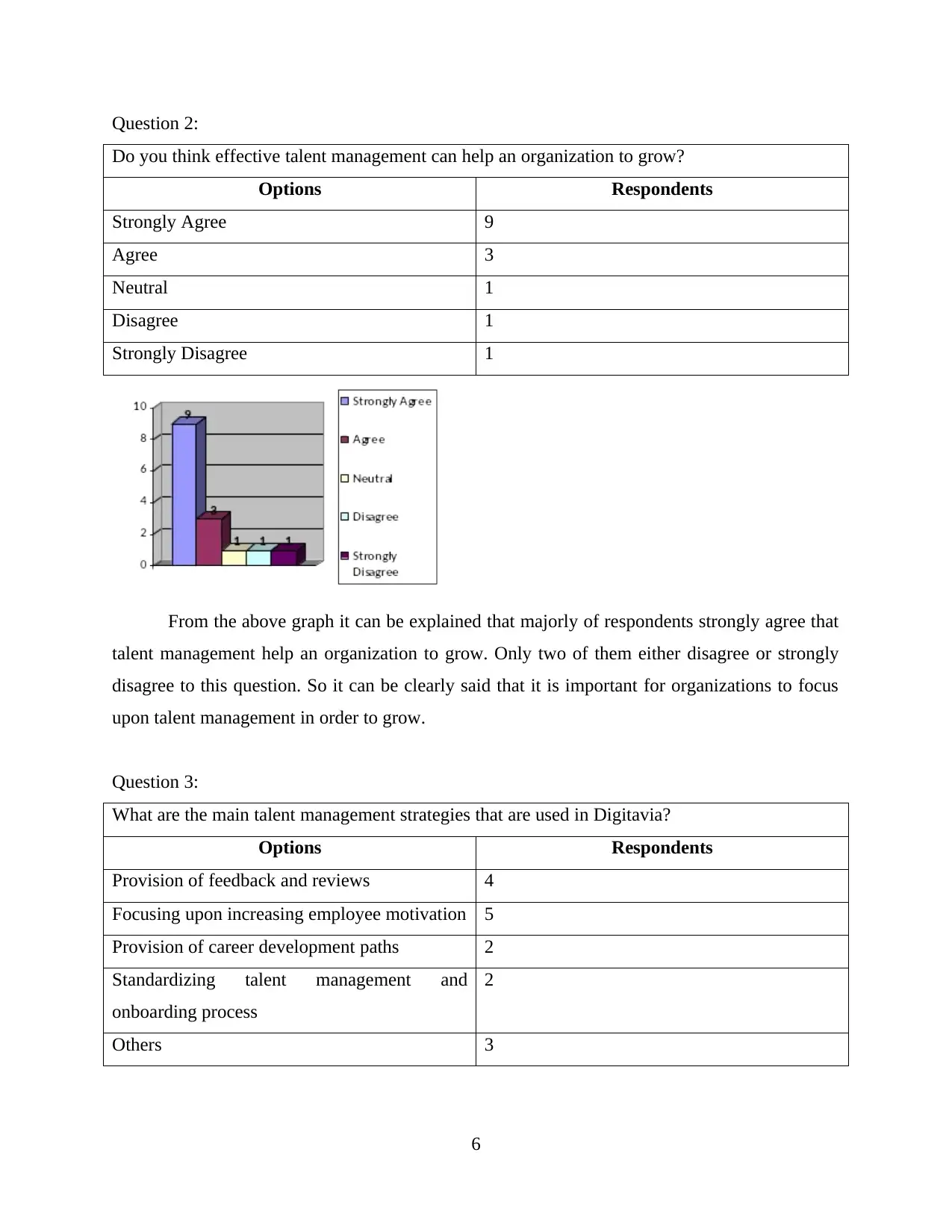
Question 2:
Do you think effective talent management can help an organization to grow?
Options Respondents
Strongly Agree 9
Agree 3
Neutral 1
Disagree 1
Strongly Disagree 1
From the above graph it can be explained that majorly of respondents strongly agree that
talent management help an organization to grow. Only two of them either disagree or strongly
disagree to this question. So it can be clearly said that it is important for organizations to focus
upon talent management in order to grow.
Question 3:
What are the main talent management strategies that are used in Digitavia?
Options Respondents
Provision of feedback and reviews 4
Focusing upon increasing employee motivation 5
Provision of career development paths 2
Standardizing talent management and
onboarding process
2
Others 3
6
Do you think effective talent management can help an organization to grow?
Options Respondents
Strongly Agree 9
Agree 3
Neutral 1
Disagree 1
Strongly Disagree 1
From the above graph it can be explained that majorly of respondents strongly agree that
talent management help an organization to grow. Only two of them either disagree or strongly
disagree to this question. So it can be clearly said that it is important for organizations to focus
upon talent management in order to grow.
Question 3:
What are the main talent management strategies that are used in Digitavia?
Options Respondents
Provision of feedback and reviews 4
Focusing upon increasing employee motivation 5
Provision of career development paths 2
Standardizing talent management and
onboarding process
2
Others 3
6
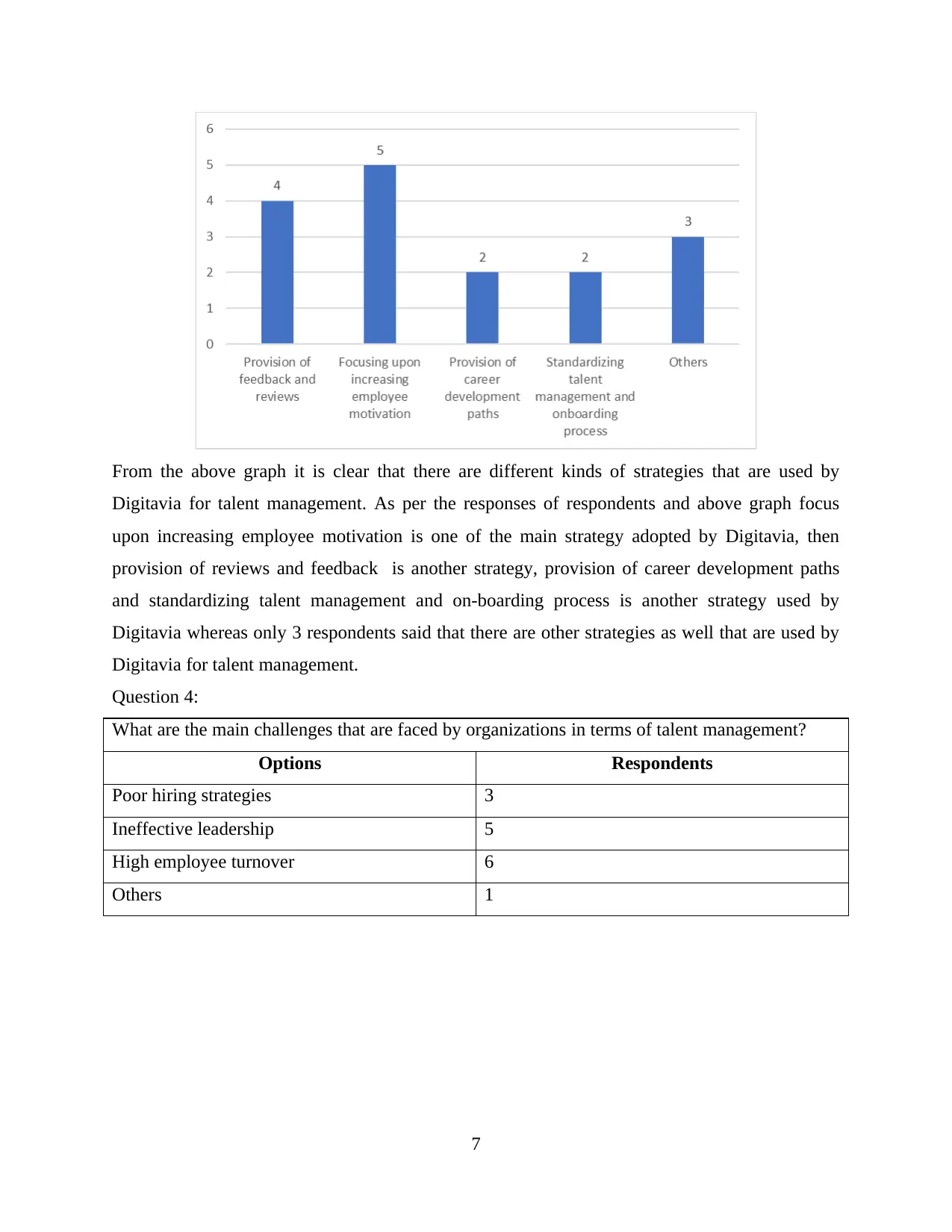
From the above graph it is clear that there are different kinds of strategies that are used by
Digitavia for talent management. As per the responses of respondents and above graph focus
upon increasing employee motivation is one of the main strategy adopted by Digitavia, then
provision of reviews and feedback is another strategy, provision of career development paths
and standardizing talent management and on-boarding process is another strategy used by
Digitavia whereas only 3 respondents said that there are other strategies as well that are used by
Digitavia for talent management.
Question 4:
What are the main challenges that are faced by organizations in terms of talent management?
Options Respondents
Poor hiring strategies 3
Ineffective leadership 5
High employee turnover 6
Others 1
7
Digitavia for talent management. As per the responses of respondents and above graph focus
upon increasing employee motivation is one of the main strategy adopted by Digitavia, then
provision of reviews and feedback is another strategy, provision of career development paths
and standardizing talent management and on-boarding process is another strategy used by
Digitavia whereas only 3 respondents said that there are other strategies as well that are used by
Digitavia for talent management.
Question 4:
What are the main challenges that are faced by organizations in terms of talent management?
Options Respondents
Poor hiring strategies 3
Ineffective leadership 5
High employee turnover 6
Others 1
7
⊘ This is a preview!⊘
Do you want full access?
Subscribe today to unlock all pages.

Trusted by 1+ million students worldwide
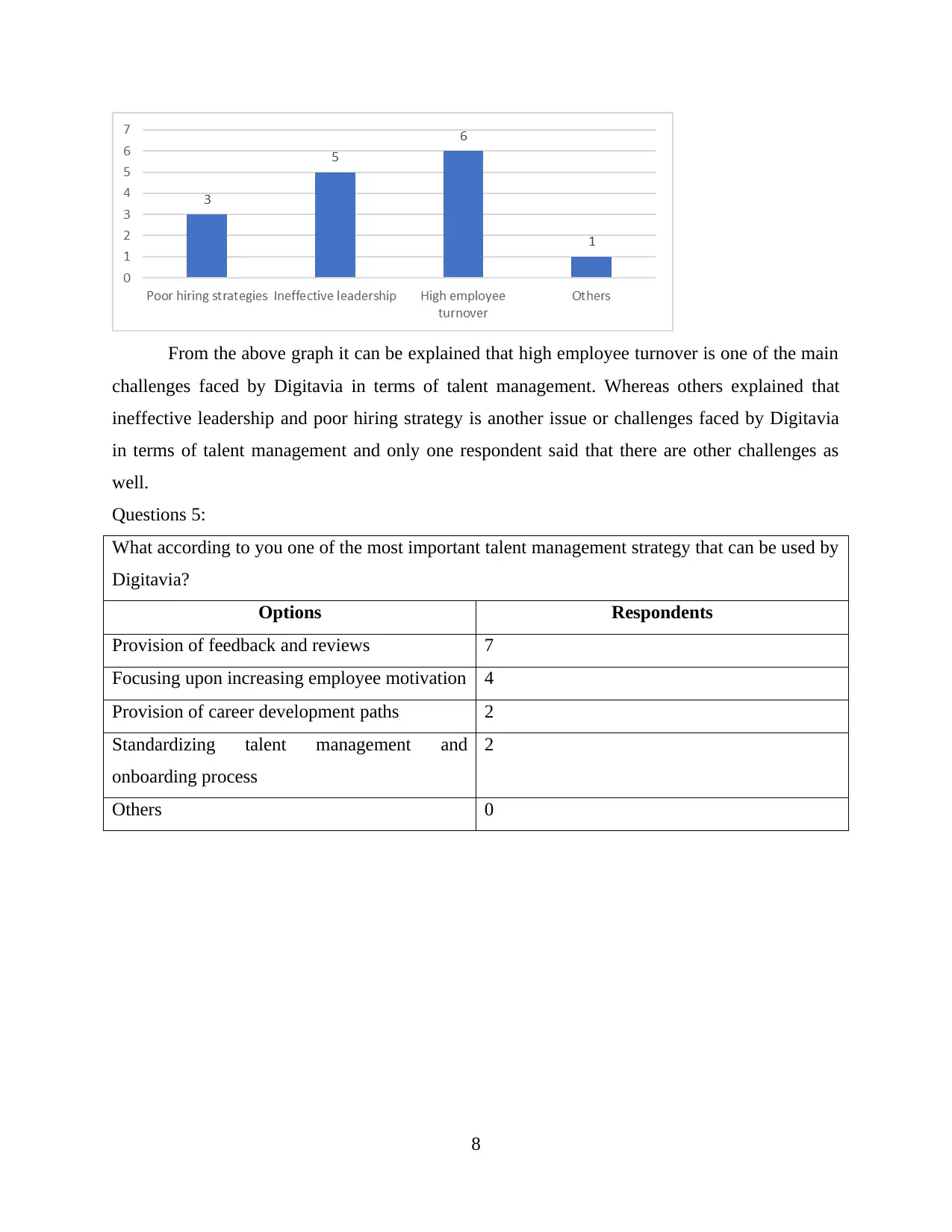
From the above graph it can be explained that high employee turnover is one of the main
challenges faced by Digitavia in terms of talent management. Whereas others explained that
ineffective leadership and poor hiring strategy is another issue or challenges faced by Digitavia
in terms of talent management and only one respondent said that there are other challenges as
well.
Questions 5:
What according to you one of the most important talent management strategy that can be used by
Digitavia?
Options Respondents
Provision of feedback and reviews 7
Focusing upon increasing employee motivation 4
Provision of career development paths 2
Standardizing talent management and
onboarding process
2
Others 0
8
challenges faced by Digitavia in terms of talent management. Whereas others explained that
ineffective leadership and poor hiring strategy is another issue or challenges faced by Digitavia
in terms of talent management and only one respondent said that there are other challenges as
well.
Questions 5:
What according to you one of the most important talent management strategy that can be used by
Digitavia?
Options Respondents
Provision of feedback and reviews 7
Focusing upon increasing employee motivation 4
Provision of career development paths 2
Standardizing talent management and
onboarding process
2
Others 0
8
Paraphrase This Document
Need a fresh take? Get an instant paraphrase of this document with our AI Paraphraser
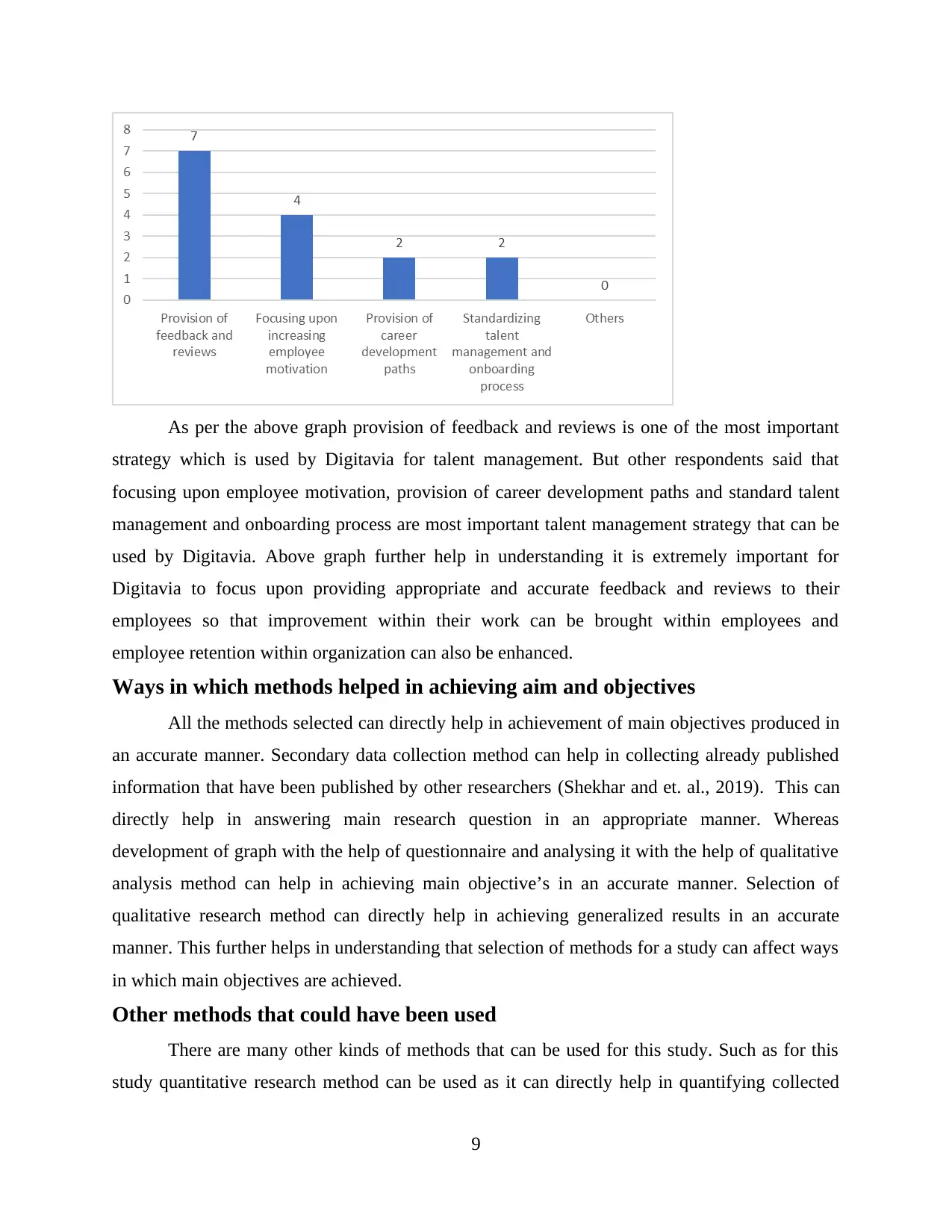
As per the above graph provision of feedback and reviews is one of the most important
strategy which is used by Digitavia for talent management. But other respondents said that
focusing upon employee motivation, provision of career development paths and standard talent
management and onboarding process are most important talent management strategy that can be
used by Digitavia. Above graph further help in understanding it is extremely important for
Digitavia to focus upon providing appropriate and accurate feedback and reviews to their
employees so that improvement within their work can be brought within employees and
employee retention within organization can also be enhanced.
Ways in which methods helped in achieving aim and objectives
All the methods selected can directly help in achievement of main objectives produced in
an accurate manner. Secondary data collection method can help in collecting already published
information that have been published by other researchers (Shekhar and et. al., 2019). This can
directly help in answering main research question in an appropriate manner. Whereas
development of graph with the help of questionnaire and analysing it with the help of qualitative
analysis method can help in achieving main objective’s in an accurate manner. Selection of
qualitative research method can directly help in achieving generalized results in an accurate
manner. This further helps in understanding that selection of methods for a study can affect ways
in which main objectives are achieved.
Other methods that could have been used
There are many other kinds of methods that can be used for this study. Such as for this
study quantitative research method can be used as it can directly help in quantifying collected
9
strategy which is used by Digitavia for talent management. But other respondents said that
focusing upon employee motivation, provision of career development paths and standard talent
management and onboarding process are most important talent management strategy that can be
used by Digitavia. Above graph further help in understanding it is extremely important for
Digitavia to focus upon providing appropriate and accurate feedback and reviews to their
employees so that improvement within their work can be brought within employees and
employee retention within organization can also be enhanced.
Ways in which methods helped in achieving aim and objectives
All the methods selected can directly help in achievement of main objectives produced in
an accurate manner. Secondary data collection method can help in collecting already published
information that have been published by other researchers (Shekhar and et. al., 2019). This can
directly help in answering main research question in an appropriate manner. Whereas
development of graph with the help of questionnaire and analysing it with the help of qualitative
analysis method can help in achieving main objective’s in an accurate manner. Selection of
qualitative research method can directly help in achieving generalized results in an accurate
manner. This further helps in understanding that selection of methods for a study can affect ways
in which main objectives are achieved.
Other methods that could have been used
There are many other kinds of methods that can be used for this study. Such as for this
study quantitative research method can be used as it can directly help in quantifying collected
9
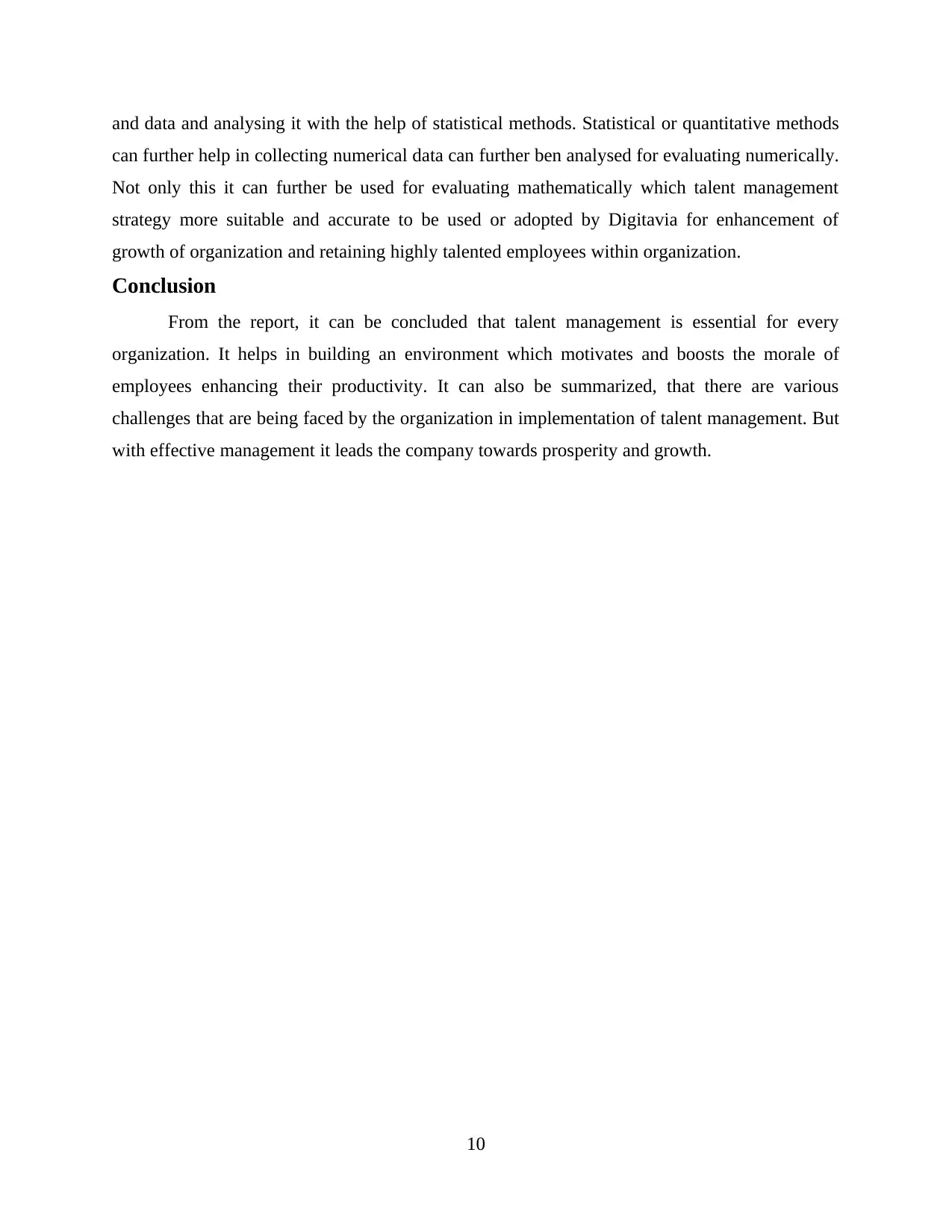
and data and analysing it with the help of statistical methods. Statistical or quantitative methods
can further help in collecting numerical data can further ben analysed for evaluating numerically.
Not only this it can further be used for evaluating mathematically which talent management
strategy more suitable and accurate to be used or adopted by Digitavia for enhancement of
growth of organization and retaining highly talented employees within organization.
Conclusion
From the report, it can be concluded that talent management is essential for every
organization. It helps in building an environment which motivates and boosts the morale of
employees enhancing their productivity. It can also be summarized, that there are various
challenges that are being faced by the organization in implementation of talent management. But
with effective management it leads the company towards prosperity and growth.
10
can further help in collecting numerical data can further ben analysed for evaluating numerically.
Not only this it can further be used for evaluating mathematically which talent management
strategy more suitable and accurate to be used or adopted by Digitavia for enhancement of
growth of organization and retaining highly talented employees within organization.
Conclusion
From the report, it can be concluded that talent management is essential for every
organization. It helps in building an environment which motivates and boosts the morale of
employees enhancing their productivity. It can also be summarized, that there are various
challenges that are being faced by the organization in implementation of talent management. But
with effective management it leads the company towards prosperity and growth.
10
⊘ This is a preview!⊘
Do you want full access?
Subscribe today to unlock all pages.

Trusted by 1+ million students worldwide
1 out of 13
Related Documents
Your All-in-One AI-Powered Toolkit for Academic Success.
+13062052269
info@desklib.com
Available 24*7 on WhatsApp / Email
![[object Object]](/_next/static/media/star-bottom.7253800d.svg)
Unlock your academic potential
Copyright © 2020–2025 A2Z Services. All Rights Reserved. Developed and managed by ZUCOL.





